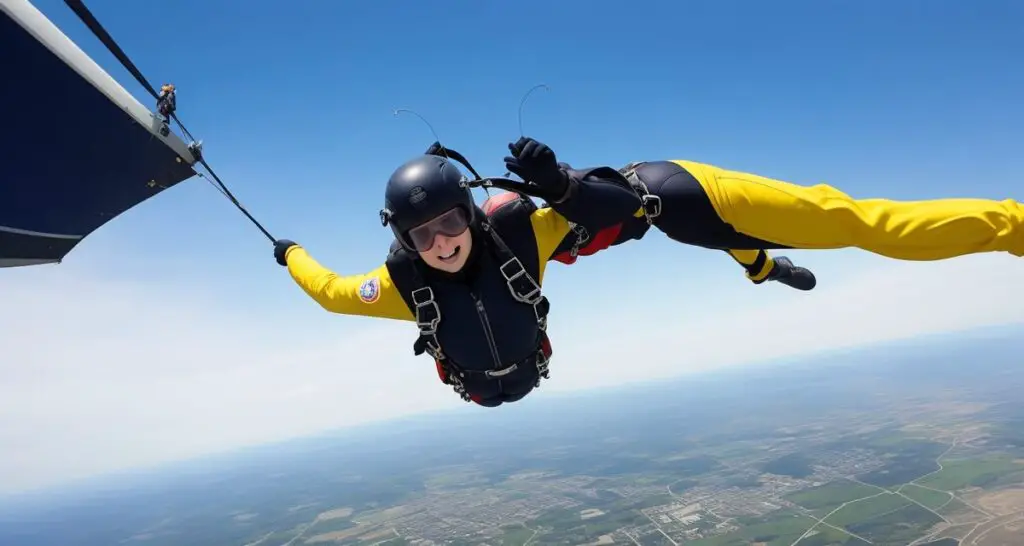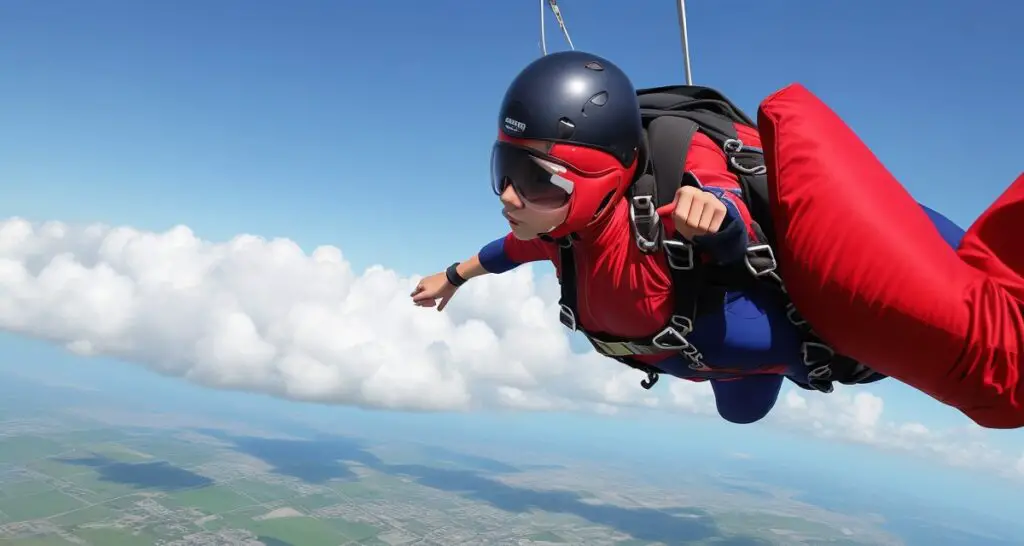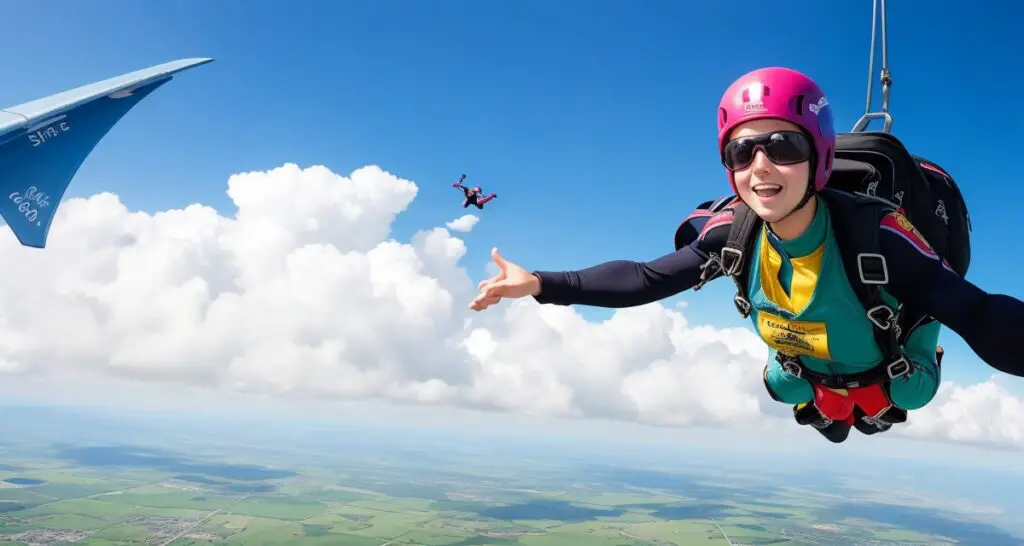Engaging in the breathtaking adventure of skydiving is a dream harbored by many, a journey that promises an unforgettable rush of adrenaline and the unique sensation of soaring through the skies. As you contemplate taking that exhilarating leap from an aircraft, it’s crucial to possess a comprehensive understanding of the financial aspects involved. In this thorough guide, we will lead you through a comprehensive exploration of “How much does it cost to do a skydive.?”
Skydiving expenses comprise several components, including the price of training, the type of jump you opt for (tandem or solo), gear rental or purchase, and any additional services you may require. Factors such as the location and altitude of the jump site also influence costs.
We’ll delve into each of these elements, offering insights into the range of expenses you can anticipate. By the time you conclude this guide, you’ll be well-equipped with the knowledge needed to make a well-informed decision, ensuring that your skydiving adventure is not only thrilling but also financially sound.
Navigating the Financial Aspects of Your Skydiving Experience

Before you take that exhilarating leap into the world of skydiving, it’s essential to understand the financial aspects involved. While the cost of a skydiving adventure can be influenced by various factors, we’re here to guide you through these consihttps://actionsporter.com/how-much-does-skydiving-cost/derations in a more detailed manner to ensure you’re fully prepared for the experience.
Jump Type:
The type of jump you choose significantly affects the cost. Tandem jumps, where you’re attached to an instructor, are typically less expensive than solo jumps, which require more training and equipment.
Location:
The cost of a skydive can vary based on the drop zone’s location. Popular tourist destinations or scenic locations may have higher price tags compared to less well-known drop zones.
Training and Certification:
If you’re considering solo jumps, you’ll need to invest in training and certification. These costs cover the necessary instruction and licensing required for solo skydiving.
Additional Services:
Some drop zones offer services like video recording or photos of your jump. While not mandatory, these can be exciting mementos but come at an additional cost.
Group Discounts:
If you’re planning to jump with a group of friends, inquire about group discounts. Many drop zones offer reduced rates for group bookings.
Seasonal Variations:
Skydiving costs can fluctuate with the seasons. Consider jumping during the off-peak season to potentially secure a lower rate.
Loyalty Programs:
Some skydiving centers have loyalty programs that reward frequent jumpers with discounts or perks.
Cancellation Policies:
Familiarize yourself with the drop zone’s cancellation policies, as there may be fees associated with rescheduling or canceling your jump.
Equipment Rental:
For solo jumps, equipment rental is a consideration. Costs may include the parachute, altimeter, and jumpsuit rental fees.
Insurance:
It’s advisable to inquire about insurance options, particularly for solo jumpers. While this adds to the initial cost, it provides coverage in case of unforeseen events.
By considering these factors and gaining a comprehensive understanding of the expenses associated with skydiving, you can make informed decisions and ensure that your financial planning aligns with the thrilling adventure that awaits.
Selecting the Ideal Skydiving Destination

The decision of where to embark on your skydiving journey is a pivotal one, as it wields substantial influence over the total costs involved. This conversation centers on the financial implications of your chosen location and aims to offer guidance on making a well-informed decision that aligns with your budgetary considerations.
Regional Variances:
Different regions and drop zones can present varying price points. Popular tourist destinations might have higher costs, while less frequented areas could offer more budget-friendly options.
Scenic Considerations:
Scenic locations, like coastal or mountainous regions, often command a premium. Consider whether the view is a priority for your jump or if a more cost-effective drop zone will suffice.
Travel Costs:
If your chosen location requires significant travel, remember to factor in transportation, accommodation, and meal expenses. These additional costs can influence the overall budget.
Local Discounts:
Research the local drop zones at your chosen destination. They might offer discounts or packages for tourists, allowing you to save on the skydiving experience.
Group Reservations:
If you plan to skydive with friends or family, explore group reservation options. Many drop zones provide discounts for group bookings.
Off-Peak Considerations:
Opting for off-peak times or seasons can often lead to reduced rates. Be flexible with your timing if you’re looking to save on your adventure.
Customer Reviews:
Before finalizing your choice, read customer reviews and testimonials. These can offer insights into the quality and value of the skydiving experience at your selected destination.
Special Packages:
Some drop zones offer special packages that include additional services like photos or videos. While these add to the initial cost, they can enhance your experience.
By thoughtfully evaluating these factors and considering your budget, you can choose a skydiving location that aligns with your financial goals while ensuring an exhilarating and memorable adventure.
Exploring the Diverse World of Skydiving Experiences

Skydiving is a world of thrilling experiences, each offering a distinct adventure. To help you navigate these options and make an informed choice aligned with your preferences and budget, we’ll delve deeper into the various types of skydiving and their associated costs.
Tandem Skydiving:
Tandem skydiving involves jumping with a certified instructor, making it an excellent choice for beginners. Prices typically range from $200 to $300, with variations based on location and additional services like photos or videos.
Solo Skydiving:
For those seeking the ultimate freedom, solo skydiving requires training and certification. Costs encompass training fees, equipment rental, and jump fees, which can range from $1,500 to $3,000 or more.
Accelerated Freefall (AFF):
AFF is a structured training program for solo skydivers. The course includes multiple jumps and training sessions and typically costs between $1,500 and $2,500.
Indoor Skydiving:
Indoor skydiving, in vertical wind tunnels, offers a unique experience. Prices range from $50 to $100 for a few minutes of flight time, with options for longer sessions at higher costs.
Wingsuit Flying:
Wingsuit flying is an advanced and specialized form of skydiving. The expense is higher due to the specialized equipment, with jumps costing around $300 to $400.
Group Jumps:
If you plan to jump with a group, inquire about group discounts. These can lead to significant savings, depending on the size of your group.
License and Certification:
Solo skydiving and AFF require training and certification costs. These vary based on the program and location, typically ranging from $1,000 to $2,000.
Additional Services:
Consider any extra services like video recordings or photos. These can enhance your experience but come at an added cost, ranging from $50 to $150 or more.
By exploring these detailed insights into the world of skydiving, you can not only choose the experience that aligns with your adventure goals but also budget effectively for the exhilarating leap you’re about to undertake.
Practical Strategies for Affordable Skydiving Adventures

For those eager to embrace the exhilarating world of skydiving without straining their finances, we’re here to provide you with a comprehensive set of guidelines and insights. These details go beyond just basic advice and delve into the finer points of making your skydiving dreams more cost-effective while retaining the thrill and safety of the experience:
Off-Peak Timing:
Consider scheduling your skydive during off-peak times or seasons. This can often result in lower prices, as many drop zones offer discounts during less busy periods.
Group Bookings:
If you’re planning to jump with friends or family, check if there are group booking discounts available. Many drop zones offer reduced rates for larger groups.
Loyalty Programs:
Explore loyalty programs offered by skydiving centers. These programs can reward frequent jumpers with discounts or benefits, contributing to long-term savings.
Special Packages:
Some drop zones provide special packages that include additional services like photos or videos of your jump. While they add to the initial cost, these packages often offer better value compared to purchasing services individually.
Membership Discounts:
Certain skydiving clubs or associations offer membership discounts for their members. Consider joining such organizations if you plan to make skydiving a regular hobby.
Budget Planning:
Develop a budget that includes all expenses, such as the jump fee, training (if required), travel costs, and any additional services. Careful planning helps you avoid unforeseen financial surprises.
Coupon Codes and Promotions:
Keep an eye out for coupon codes and promotions. Online searches or subscribing to newsletters from skydiving companies can yield valuable discounts.
Combine Multiple Jumps:
If you’re planning multiple jumps over time, consider bundling them together. Purchasing multiple jumps at once can lead to significant savings.
Local Drop Zones:
Research local drop zones and compare their prices with more famous or tourist-heavy destinations. You might find more budget-friendly options closer to home.
Quality Assurance:
While seeking affordability, never compromise on safety or quality. Prioritize drop zones with excellent safety records and experienced instructors.
By following these in-depth strategies and considering your budget, you can savor the thrill of skydiving without incurring unnecessary financial strain. Making informed decisions, selecting the right time and location, and seeking available discounts and packages are key steps in ensuring that your skydiving adventure remains both unforgettable and affordable.
Exclusive Offers for Groups and Tailored Packages
Skydiving centers often extend their hospitality by offering group discounts and specially crafted packages to enhance your adventure while keeping your expenses in check. Here’s a more detailed exploration of how you can leverage these offerings to create an unforgettable skydiving experience:
Group Discounts:
When planning a skydiving outing with friends or family, inquire about group discounts. Many drop zones provide reduced rates for groups, and the larger your group, the greater your potential savings.
Customized Group Packages:
Some skydiving centers offer customized group packages that include multiple jumps, photos, videos, or additional services. These packages often present better value than individual bookings.
Coordination and Communication:
Effective coordination and communication are key. Work closely with the skydiving center to arrange your group adventure, ensuring that everyone’s preferences and schedules align.
Off-Peak Group Bookings:
Consider booking your group adventure during off-peak times or seasons to secure even more significant discounts. Off-peak periods typically offer reduced rates.
Safety and Training:
Prioritize safety and training for all members of your group, especially if some are first-time skydivers. Ensuring everyone is adequately prepared enhances the overall experience.
Loyalty and Membership Benefits:
If your group plans to make skydiving a regular activity, explore loyalty programs and membership benefits. These can result in long-term discounts and perks.
Deposit and Reservation Policies:
Understand deposit and reservation policies for group bookings. Ensure that your group members are committed to the adventure to avoid any last-minute changes.
Quality Assurance:
While seeking affordability, never compromise on safety or quality. Choose a reputable drop zone with experienced instructors and a strong safety record.
By thoroughly exploring these strategies and embracing the collaborative spirit of group bookings, you can share the excitement of skydiving with friends or family while optimizing your expenses. These carefully planned adventures promise both affordability and a remarkable bonding experience in the exhilarating world of skydiving.
Unpacking Tandem Skydiving Expenses
For those contemplating the exhilarating world of tandem skydiving, a detailed understanding of the costs involved is essential. Tandem skydiving, where you jump with a certified instructor, is a popular choice for first-time adventurers. To ensure you’re fully informed before taking the leap, let’s dive deeper into the breakdown of tandem skydiving expenses:
Jump Fee:
The core cost of tandem skydiving is the jump fee. This typically ranges from $200 to $300, with variations based on location, the drop zone’s popularity, and any additional services included.
Additional Services:
Tandem skydiving packages may offer additional services, such as professionally captured photos and videos of your jump. These services come at an extra cost, often ranging from $50 to $150, providing you with memorable mementos of your adventure.
Location:
The geographical location of the drop zone can influence tandem skydiving prices. Popular tourist destinations or regions with scenic views may command higher fees.
Travel Expenses:
If the selected drop zone requires significant travel, remember to factor in transportation, accommodation, and meal costs. These can add to the overall expenses of your tandem skydiving experience.
Group Discounts:
If you plan to tandem jump with friends or family, inquire about group discounts. Many drop zones offer reduced rates for group bookings, potentially lowering the individual cost.
Off-Peak Timing:
Consider scheduling your tandem skydive during off-peak times or seasons. This can lead to reduced rates, as many drop zones offer discounts during less busy periods.
Quality Assurance:
Ensure the safety and expertise of the drop zone and instructors. Prioritize established drop zones with experienced professionals, even if their fees are slightly higher.
By comprehensively exploring these facets, you’ll gain a nuanced understanding of tandem skydiving expenses. Armed with this knowledge, you can make a well-informed decision, ensuring that your tandem skydiving experience is not only thrilling but also budget-friendly.
Diving into the Financial Aspects of Solo Skydiving
When you’re considering the solo skydiving experience, it’s crucial to delve into the financial details to make an informed decision. Solo skydiving, which involves jumping on your own after completing necessary training and certification, comes with specific costs and considerations. To provide a comprehensive understanding, let’s explore the finer points of the expenses involved:
Training Costs:
The most substantial expense for solo skydiving is the training. To jump solo, you must complete a comprehensive training program, such as the Accelerated Freefall (AFF). Training fees typically range from $1,500 to $2,500, depending on the program and location.
Equipment Rental:
Solo skydivers need to rent equipment, including a parachute, altimeter, and jumpsuit. Rental fees can vary but are generally part of the overall cost, typically ranging from $50 to $100.
Jump Fees:
The cost per jump can range from $150 to $300 or more. This fee covers the plane ride, equipment use, and drop zone services.
Additional Services:
Just like tandem skydiving, solo jumps may offer additional services like video recordings or photos for an extra fee, typically ranging from $50 to $150.
License and Certification:
You’ll need to acquire a skydiving license, which may involve additional expenses, usually ranging from $1,000 to $2,000. This cost covers certification and other related fees.
Location and Popularity:
The geographical location of the drop zone and its popularity can influence costs. Locations in tourist destinations or with scenic views often have higher prices.
Quality Assurance:
Prioritize drop zones with a strong safety record and experienced instructors. While this may slightly increase costs, it ensures a safer and higher-quality experience.
By delving into these detailed considerations, you’ll gain a comprehensive understanding of the expenses associated with solo skydiving. Armed with this knowledge, you can make well-informed choices as you venture into the exhilarating world of solo jumps, ensuring not only an incredible experience but also a budget-friendly one.
Navigating Unforeseen Expenses in Your Adventure
In the course of any adventure, it’s prudent to be prepared for potential hidden fees and unexpected costs that might arise. To offer a more detailed perspective, let’s delve into the specifics of these additional expenses and equip you with insights on how to manage them effectively:
Travel Expenses:
When planning your adventure, consider travel costs such as transportation to the location, accommodation, and meals. These expenses can significantly impact your overall budget.
Equipment Rentals:
Depending on the adventure, you may need to rent specialized equipment or gear. These rental fees should be factored into your budget.
Service Fees:
Some adventures come with service charges. These may include guide fees, park entry fees, or equipment setup charges.
Insurance:
Explore insurance options relevant to your adventure. While this adds to the initial cost, it offers coverage in case of unforeseen events.
Cancellation and Rescheduling Fees:
Familiarize yourself with cancellation and rescheduling policies. Some adventures may incur fees for last-minute changes to your plans.
Upgrades and Add-Ons:
During your adventure, you may be offered upgrades or additional services such as guided tours or extra features. These improvements typically involve an associated expense.
Photography and Mementos:
Many adventure experiences offer photography or videos of your journey. These memorabilia items may be available for purchase but come at an extra cost.
Group Discounts and Special Packages:
Conversely, some adventures may offer group discounts or special packages that can lead to savings if you’re traveling with companions.
Unplanned Expenses:
Be prepared for unexpected costs that might arise during your adventure. Having a contingency fund can help you manage these unforeseen expenses.
Quality Assurance:
Prioritize safety and quality by choosing reputable providers and ensuring that they adhere to safety standards. While this may impact costs, it ensures a safer and more enjoyable experience.
By exploring these intricacies and understanding the full spectrum of potential expenses in your adventure, you’ll be better equipped to manage your budget effectively, enabling you to enjoy your journey while minimizing the impact of unanticipated financial surprises.
Conclusion
The cost of a skydiving adventure can vary widely, influenced by factors such as the type of jump, location, and additional services. While careful budgeting and seeking discounts can help manage expenses, the true value of a skydive extends beyond the price tag. The exhilaration, breathtaking views, and memories created during a skydive are immeasurable, making it a worthwhile investment in unforgettable experiences that last a lifetime. So, whether you’re looking to make an adventurous leap or enjoy a thrilling group outing, the cost of a skydive is a small price to pay for the incredible and enduring memories it offers.
FAQs Of How Much Does It Cost To Do A Skydive?
What is the average cost of a tandem skydive?
The average cost of a tandem skydive typically ranges from $200 to $300. Prices can vary depending on the location, the popularity of the drop zone, and any additional services you may choose.
How much does it cost for solo skydiving, including training?
The cost of solo skydiving, which includes training, can range from $1,500 to $2,500. This cost covers training fees, equipment rental, and jump fees.
Are there additional costs to consider beyond the jump fee?
Yes, there can be additional costs to consider. These may include travel expenses, equipment rentals, service fees, insurance, photography or video fees, and any upgrades or add-ons you choose.
Can group bookings save on skydiving costs?
Group bookings often come with discounted rates, which can lead to significant savings. Many drop zones offer reduced prices for larger groups.
What can I do to make skydiving more budget-friendly?
To make skydiving more budget-friendly, consider scheduling your jump during off-peak times, explore loyalty programs, join group bookings, and be aware of any additional expenses. Budgeting and careful planning are key to managing costs effectively.

